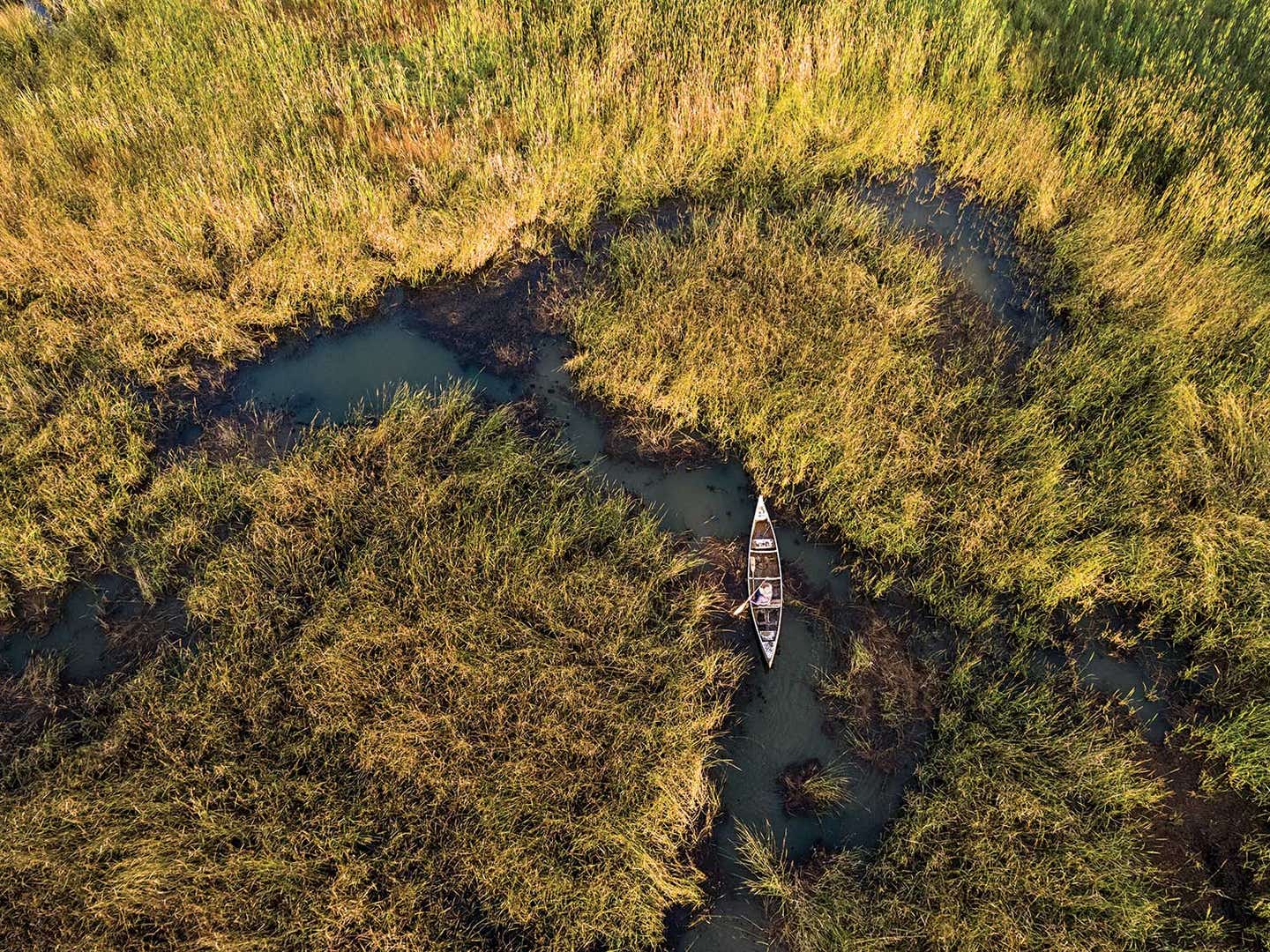
The True Story of Wild Rice, North America’s Most Misunderstood Grain
The Ojibwe people of northern Minnesota are sustained by the real wild rice, which they harvest by hand and dry over fire
On a sunny afternoon in the last days of summer, I broke the first rule I had ever been taught about watercraft and stood up in a canoe. Mike Magney and Moon Jacobson of the White Earth Band of Ojibwe had offered to take me out onto Little Elbow Lake and show me the wild-rice harvest—not as a past-tense reenactment, we agreed, but in a present-tense this is how we do it sort of way. So as their canoe shot surely ahead into a thick stand of rice, I heaved my weight onto a 12-foot-long pole in an attempt to keep up. The wind took fierce bites out of the water, working against me. Cotton-batting clouds sped across the blue gel of the sky. The northern Minnesota wild-rice harvest takes place during a two-week sliver of September, and the racing wind heightened our urgency.
We were at Sahkahtay, an annual wild-rice camp hosted by members of the Ojibwe tribe, one of the largest groups of Indigenous people north of Mexico, most of whom live in a long arc that stretches from the upper Midwest to Quebec.
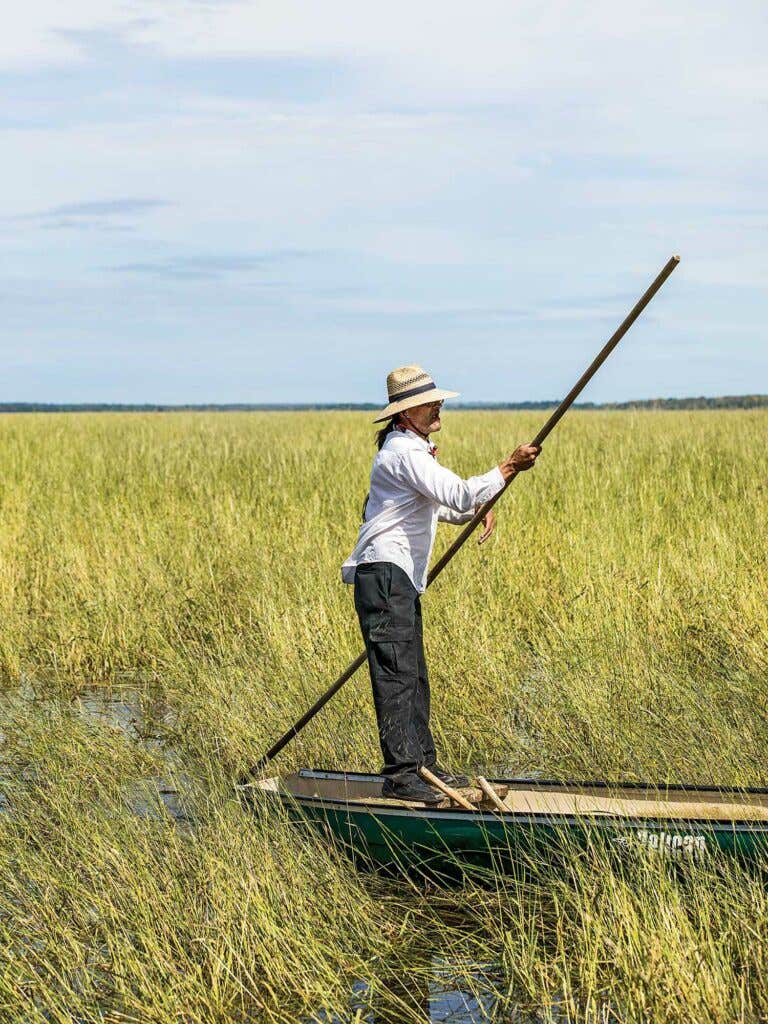
Jacobson was at the three-day festival to teach ricing skills to the next generation and to harvest his own 50 pounds—"about half of what my grandma calls a year's supply." He grew up in Minneapolis but spent a lot of time with his grandmother in Mahnomen, a nearby town of 1,200. He followed her around, helping her put up her year's worth of food: harvesting berries, foraging for medicinal plants, and filling a buried chest freezer in her yard with whole walleye, which the arctic Minnesota temperatures swiftly preserved to stiffness.
Magney stood at the back of the canoe, pushing his pole into the thick chocolate mud of the lake bottom, using its lever action to propel them across the water. Jacobson sat in the front with a short wooden stick—called a knocker—in each hand. The stands of rice are thickest 20 feet from shore, and we rolled into them as if into a darkened forest of pencil-thin bamboo, the rice seed heads rattling like a dorm-room bead curtain. Plunging one knocker into the rice stand, Jacobson parted the stalks like hair, bending a thick hank over his lap with one hand and neatly sweeping off its loose seed heads with the other. Rice rained down obediently into the canoe as they moved forward, his poles tapping out a click-click-click rhythm born of years of repetition.
Wild rice is one of the only grains native to North America, and definitely its most misunderstood. It is not directly related to Asian rice. What’s more, the black rice you see in countless Thanksgiving stuffing recipes every fall is an imposter. Here in northern Minnesota, at the center of the genetic reserve of wild-rice seedstock, where it grows naturally in lakes and creeks, we call that black stuff by its proper name: paddy rice. In the 1960s, the University of Minnesota began domesticating wild rice. They planted it in rows in flooded paddies, which they drained to harvest by combine like any other field crop. Ironically, paddy-grown rice isn’t wild at all.
Real wild rice varies in shape and color from lake to lake, but once cooked, it is always some shade of luminescent milky brown—the color of tea spilled onto a saucer. It curls into loose ringlets that pop delicately between your teeth. It tastes the way a morning campfire smells: of smoldering wood coals and lake fog at dawn.
I'd been a guest of Sahkahtay as a curious local once before—I live 20 miles down the road—but this time I was more attuned to the language of this harvest. Some people there referred to the grain we were harvesting—a foundation of Ojibwe culture and ceremony—as manoomin, "the food that grows on water." No one called it "wild." Mostly, everyone just called it rice.
We headed to the shore, where a group was cooking the green rice in a giant cast-iron kettle. Like coffee beans, wild-rice kernels need to be roasted, or parched, over heat to firm their tawny core and dry for long-term storage.
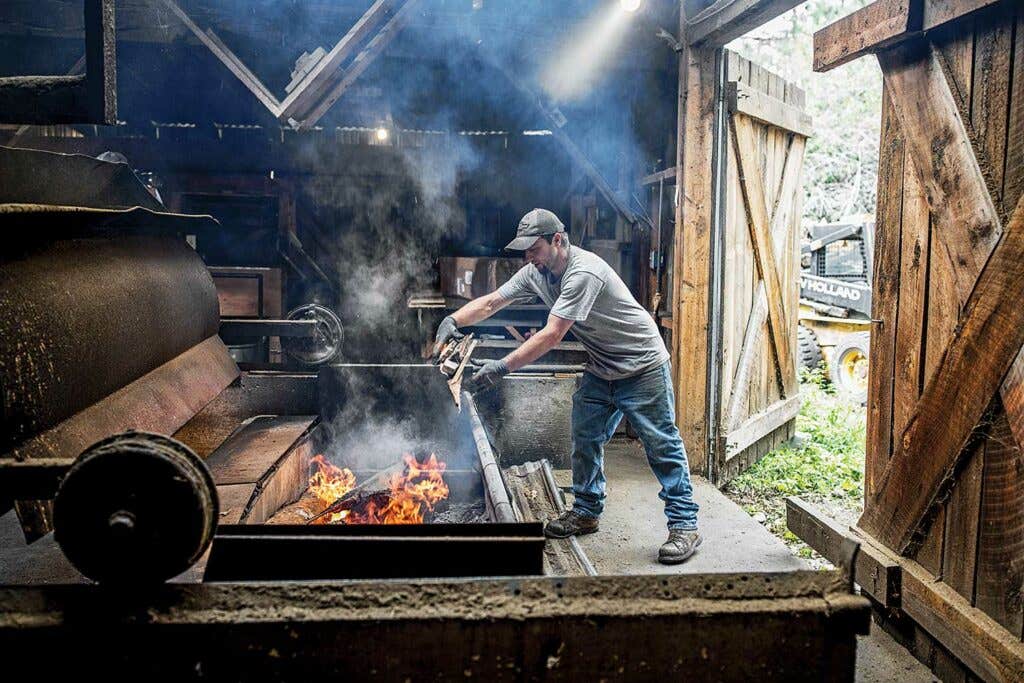
Jacobson introduced me to Logan Cloud, an artfully tattooed, soft-voiced 20-something member of the Leech Lake Band of Ojibwe. While parching rice in an iron kettle over a birch-wood fire, he described the difference between wild rice and paddy rice in blunt terms: “Paddy rice is the Western mindset, in edible form,” he said.
The story of how real wild rice lost its name is a long tale of appropriation—nothing less than one of the greatest identity thefts in American food history. Its story is braided tightly into the history of this region, a remote area where the economy, for both Native peoples and white settlers, has generally been one of subsistence. But it was the mostly white-owned paddy-rice industry, centered in California, that pushed to make wild rice a marketable commodity. In the ’70s, wild-rice prices soared, sending both tribe members and whites out onto the lakes in record numbers. Money—or at least the prospect of it—drove everyone to excess. People harvested too early, before the rice had a chance to reseed itself, wiping out once-flush stands. Tribe leaders moved without consensus to sow spent reservoirs with seeds from other waterways, wiping out age-old varieties. The University of Minnesota bred a rice with a thick stem that could handle mechanical harvesting, without any thought to the way it would cross-pollinate with the native plants.
Cloud bounced some hot, smoking rice onto the canoe paddle he was using as a stir stick, and lobbed a few kernels into his mouth to test for doneness, crunching audibly and spitting out the hulls. He threw another log onto his fire and described how he knew that the rice was getting close when it turned the toffee color of Golden Crisp cereal, “the one with the bear on the box.” He first went ricing at age 9 with his best friend, a portable radio set up in their canoe, to make some extra cash to buy the sneakers and jeans that fourth grade required. At his dad’s backyard rice camp, they parched rice over live fire in a steel drum.
At the point of first colonial contact, the Ojibwe smoke-dried their rice in birch-bark vessels strung up high over the fire. Cloud explained that these gave way to kettles sometime after “the invaders arrived and we realized that we could take something useful from them.”
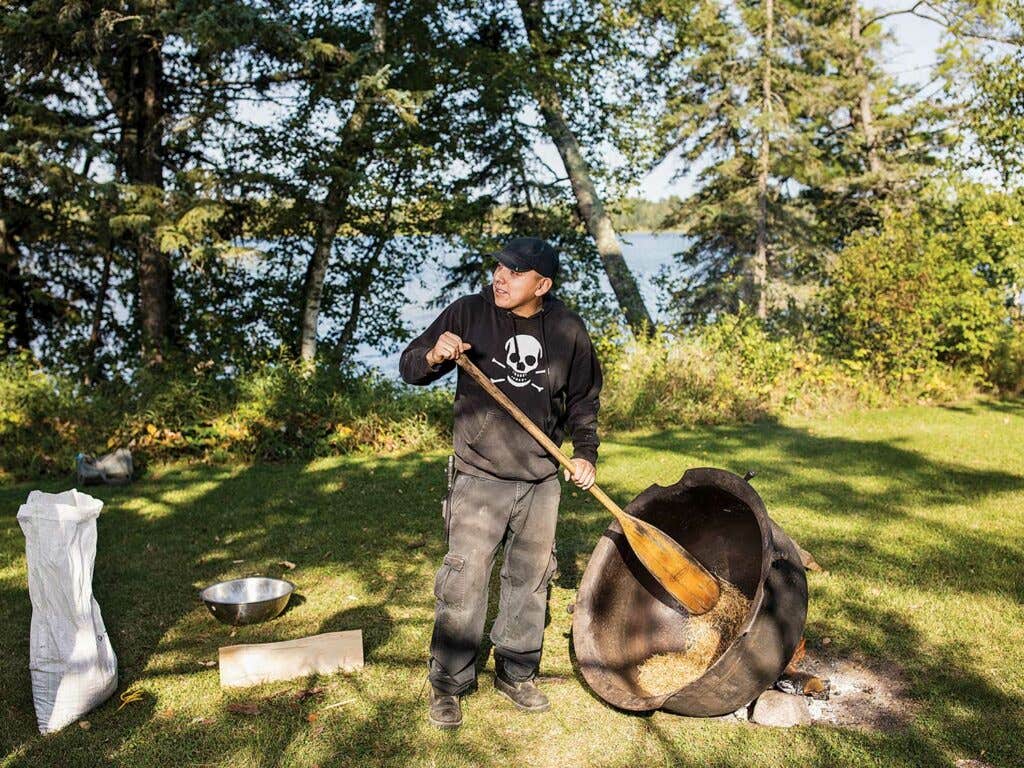
Cloud moved to a treading pit lined with birch bark and filled it with about 6 inches of parched rice, then asked a volunteer in high moccasins to “jig” the rice, to loosen its hulls. She danced in short, halting steps, light and twisting at the hip. A drummer hammered out a bass beat, steady and hypnotic, the tempo set to keep the jigger jigging. Cloud transferred the rice to a shallow birch-bark basket and tossed it in the wind. This method was surprisingly effective at winnowing away the hulls, but still, it was hardly a speedy process. By the time it was finished, every grain of rice had passed through someone’s hands and every stray hull had been flicked out onto the grass.
Camps like this one anchor traditional ricing knowledge in the present, but they also function as social gatherings. Every- one I talk to at Sahkahtay remembers going to rice camps as children, where they moved through the harvest as if in reverse: first sitting next to the elders sorting out hulls, jigging as they got older, harvesting and parching as young adults. The people who come to Sahkahtay want to parch 50 or 60 pounds of rice for their own extended family in the most traditional and flavorful way, and preserve the social history.
Given that many local Ojibwe now parch in large steel-drum barrels over wood fires, Cloud’s iron kettle seems like a throwback. I asked him: In the long history of rice parching, from birch-bark vessels to the larger barrel parchers used today, why stop here? Why parch in the iron kettle? He smirked. “Doing it this way is like fixing your own car.” Then he said, more seriously: “When we began to mechanize the parching, we started thinking in a colonized way. Processing rice became easier, but our lives did not get easier.”
As we talked about large-batch parching, the age-old battle lines drawn between mechanization and handcraft, science and intuition, we ate wild rice from foam bowls. "Paddy rice is like chewing on wood chips," he said. "It'll stab your gums." But his real wild rice, cooked simply and sauced with maple syrup, fell lightly from my spoon like snow, and melted almost instantly on my tongue. My small bowlful somehow filled me up. Simultaneous lightness and heft is one of its gifts.

Cloud, throwing fresh logs under a batch of green rice, described his small-scale parching in a sensory way. But his narrative quickly made tracks down the path of his people's history: the original prophecy that led them to the rice beds; Ojibwe astrology; the Christian missionaries intent on converting the natives; the boarding schools that separated children from their families, their language, and their ceremonies. And he circled back to where we began: the enormous paddy rice operations that inject science and greed into what should perhaps remain an intuitive process. "Both the scientist and the preacher, they want to know everything. They want to remake rice in their image."
Machinery and temperature gauges can break, making you question your own good judgment. And these modern methods can distance you from your culture. "If it weren't for the rice, Ojibwe culture wouldn't be here today," he said, moving a log with his boot, squinting from the glare of the white sun sinking toward the lake. "And if we lose it, we won't exist as a people for long. We'll be done too."
Even here, where wild rice grows abundantly, it can be hard to find a bag of the real thing. The grocery stores stock jet-black paddy rice and, occasionally, a few bags of sturdy, wood-parched Canadian wild rice. To get my yearly 10 pounds of the soft rice harvested nearby, I have to rely on my local connections.
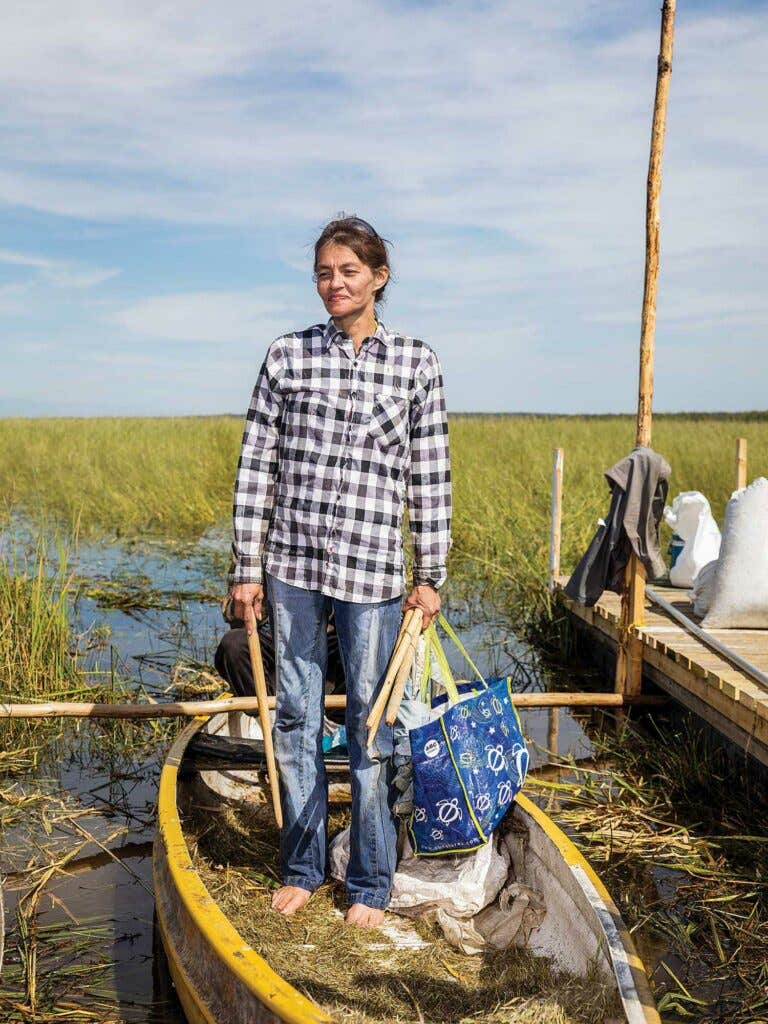
Twenty miles down the road, in a parching shed near the town of Ponsford, on the White Earth Reservation, a fat black iron barrel the size of a commercial propane tank rolled on its spit over a jumping fire. The thick sweat of rice parching hung in the air, a mixture of smoke and water and grain. The toasting rice in the barrel exhaled humidity in quick, short bursts. Like a priest’s swinging censer, it gave off a thick smudge that rose up to the high crease of the shed’s peak. I’ve been buying rice from the Dewandeler’s parching operation for years—first from Lewy, now passed on, then from his son Richard, and now from Lewy’s grandson, Aaron. Among local wood-parched wild-rice processors, their shed is the cathedral. They parch in machines they’ve fabricated over the years. A 90-year-old engine pulled from a Ford Model A powers the huge barrel that spins over the wood fire. A cylinder painted sky blue houses a flywheel of soft paddles engineered to gently knock off the loosened hulls. And now Aaron has a new baby: a giant mechanical separator. It gyrated in the middle of the room, its screen plate shaking the good, beautiful finished rice to one end and the broken, undesirable rice to the other.
Three generations of parchers, and they all judge doneness differently. “You know how you don’t listen to your parents? My dad wouldn’t listen to his, and I didn’t listen to mine. My grandpa, he could see the doneness in the smoke, in the blue haze coming off the hot barrel. My dad can smell when it’s done. Me, I have a laser. And I taste it.”
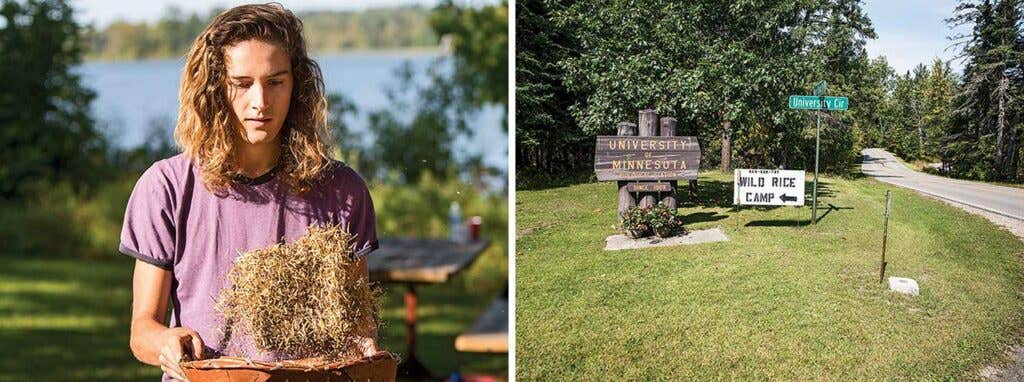
He shot the laser into the rice to test temperature, then dipped a broom into the barrel, vigorously rubbed some loose kernels between his hands, and threw the rice into his mouth. Like most parchers, he can taste which body of water the rice came from. “This is heavy rice—mostly from Shell and Basswood lakes, but I like small-creek rice best. The little kernels take on more of the smoke.”
Aaron is white but has a complicated interface with Native culture common in the area. His kids are White Earth members; his grandparent’s farm is on the reservation, but only because the majority of White Earth land has been owned by non-native people since its inception.
He parches rice very differently from Logan Cloud, but they have some things in common: a desire to protect the genetic diversity of local rice, and a hatred for paddy rice—and for sand. Sand that gets in the rice, whether in the canoe or in the parching shed, is the enemy. Once it’s in, you can’t get it out. Every chance he gets, Aaron sweeps his cement floor clean.
He paused when a black Chevy Tahoe rolled up. “It’s the tribe, here to collect their rice,” he said, and started heaving the first of 15 burlap sacks toward the door. He loaded 900 pounds of finished rice into the back end, and the Tahoe slumped.
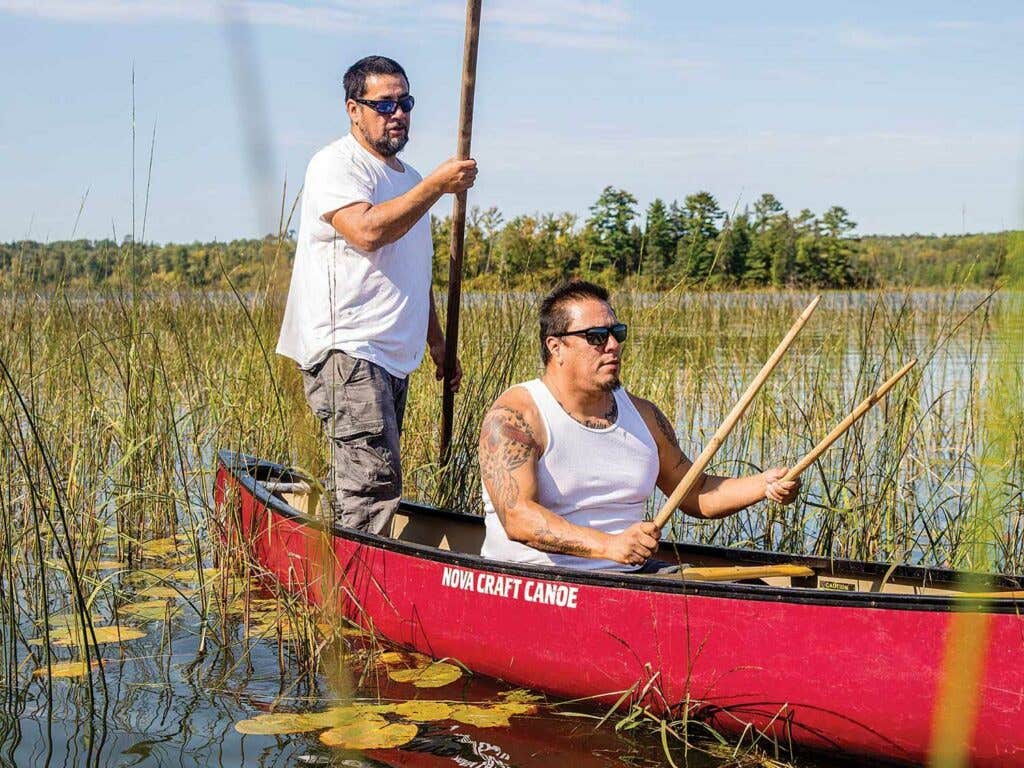
Aaron’s operation is as big as it gets around here. He parches tens of thousands of pounds of rice each fall, all within three weeks—possibly the limit for a solo operation. He usually sells out before Thanksgiving.
Two weeks later, Aaron texted me: “Come get your rice. It’s sitting there making my grandma nervous.” When I arrived, I found Bette Dewandeler in a housecoat at the kitchen table, sorting scrap-paper orders, her wit as dry as ever. Once a fixture behind the counter of the local post office, Bette would send me boxes of rice when I lived in New York City. As she is recently retired, everyone must now come to her.

As we talked, two trucks pulled up. My neighbors Adeline and Winnie walked into the kitchen, followed by some other guys I didn’t recognize, all of them with checkbooks in hand. Here, under the bright light of Bette’s kitchen, her table piled with plastic bags of rice and checks and wrinkled magazines, the transaction has the warm veneer of an illicit thrill, as if we’re buying something that will get taken away.
And it might. While the rice still grows wild on many local lakes and creeks, clogging up open channels the first week of September, its future is in question. Climate change and genetically modified rice threaten the manoomin seedstock. In this area alone, seven distinct varieties are at risk of being reseeded with hybridized rice, which ducks move from lake to lake. State wildlife management workers blow up beaver lodges, interfering with the natural water-level consistency that wild rice requires. Runoff seeps into the soil, raising sulfide levels above what this sensitive plant can handle.
The tribes continue to sell and ship out rice—some of it coming straight from Dewandeler’s parching shed—via their websites. And yet it feels like the local interest in hand-harvested, wood-parched rice—the smoky, good stuff—is on the wane. Most small-town gas stations used to sell a few bags in the fall but rarely continued the practice when they gave way to national chains. Meanwhile, health-food advocates—the same people who talk a big game about high-protein organic grains—ignore the one right under their noses.
But viewed another way, the rice has returned to the tribes and to the small parchers. It sits where it always has: in sheds and garages, tightly sheltered in burlap sacks, far from the masses—perhaps just where it belongs.
Keep Reading
Continue to Next Story










